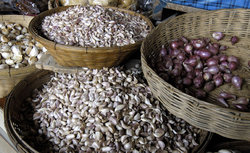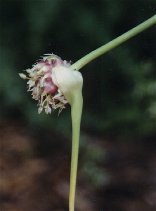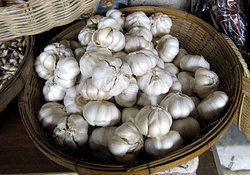Garlic
|
|
Garlic (Allium sativum) is a bulbous perennial food plant of the family Alliaceae. The word comes to us from Old English gārlēac, meaning "spear leek".
The bulb has a strong and characteristic odor and an acrid taste, and yields an offensively smelling oil, essence of garlic, identical with allyl sulphide (C6H10S2). When eaten in quantity, garlic may be strongly evident in the diner's sweat the following day. The well-known phenomenon of "garlic breath" can be alleviated by eating fresh parsley and this is included in many garlic recipes. Because of its strong odor, garlic is sometimes called the "stinking rose".| Contents |
Cultivation and plant structure
Because of its wide cultivation, the origins of garlic are uncertain; it has been traced to both southwest Siberia and Sicily, where it grows wild. It is related to onions and lilies, and cultivated in the same manner as the shallot. The domesticated garlic plant does not produce seeds, but is grown from bulbs. These bulbs, whose segments are usually called "cloves" by cooks, are the part of the plant most commonly eaten, though some cooks also use the early spring shoots. These shoots are often pickled in Russia and states of the Caucasus and eaten as an appetizer. A common error of beginning cooks is to misinterpret the word "clove" as meaning the entire garlic bulb, rather than one of its segments, thereby wildly exaggerating the amount of garlic in a recipe.
The garlic plant has long, narrow, flat, obscurely keeled leaves, a deciduous spathe, and a globose umbel of whitish flowers, among which are small bulbils. The bulb has membranous scales, in the axils of which are 10 or 12 cloves, or smaller bulbs. From these new bulbs can be procured by planting out in late winter or early spring.
Selfsufficientish.com (http://www.selfsufficientish.com/garlic.htm#grow) provides the following growing instructions:
- Plant the individual cloves from a garlic plant in drills of 5 cm (2 in) and 15 cm (6 in) apart. Ideal soil pH is in the 6.2 to 6.8 range.
- Garlic grows best in hot wet conditions, but try it all year round. It is pretty hardy and will live through frosts.
- Ensure that the growing area is weed free.
- Garlic likes water; in a hot climate it may need to be watered daily. If the shoots look dry then it is a sign that the plant needs a 'drink'.
Garlic is ready to harvest about four months after it has been sown. At this point the foilage will loose its colour and die back. Dig up with a fork to avoid damaging the bulbs.
The percentage composition of the bulbs is given by E. Solly (Trans. Hon. Soc. Loud., new ser., iii. p. 60) as water 84.09%, organic matter 13.38%, and inorganic matter 1.53% - that of the leaves being water 87.14%, organic matter 11.27% and inorganic matter 1.59%.
Uses
Culinary use
Garlic is most often used as a seasoning or a condiment, and is believed to have some medicinal value[1] (http://www.garlic-central.com/garlic-health.html), notably against hypertension. When crushed or finely chopped it yields allicin, a powerful antibiotic and anti-fungal compound. It also contains alliin, ajoene, enzymes, vitamin B, minerals, and flavonoids.
Allicin has been determined to be the agent behind the spiciness of raw garlic. This chemical opens thermoTRP (transient receptor potential) channels which are responsible for the sense of noxious heat in foods. The process of cooking garlic removes allicin, thus mellowing the spiciness of garlic. (Macpherson et al., 2005)
Medicinal use
Garlic is claimed by some to have many significant medicinal benefits, but there has been no demonstration of the effects of garlic that meets commonly accepted scientific standards.
Pliny (N.H. xx. 23) gives an exceedingly long list of complaints in which it was considered beneficial. Dr T Sydenham valued it as an application in confluent smallpox, and, says Cullen (Mat. Med. ii. p. 174, 1789), found some dropsies cured by it alone. Early in the 20th century, it was sometimes used in the treatment of pulmonary tuberculosis or phthisis.
Garlic cloves continue to be used by aficionados as a remedy for infections (especially chest problems), digestive disorders, and fungal infections such as thrush. They are claimed to be an effective long-term remedy for cardiovascular problems reducing excessive blood cholesteral levels, atherosclerosis, the risk of thrombosis, and hypertension but these claims are disputed as there has been no clinical trial that has demonstrated any such benefits. Garlic is also alleged to help regulate blood sugar levels, and so can be helpful in late-onset diabetes, though people taking insulin should not consume medicinal amounts of garlic without consulting a physician. In such applications, garlic is best used fresh.
History
From the earliest times garlic has been used as an article of diet. It formed part of the food of the Israelites in Egypt (Numb. xi. 5) and of the labourers employed by Cheops in the construction of his pyramid. Garlic is still grown in Egypt, where, however, the Syrian is the kind most esteemed (see Rawlinson's Herodotus, 2.125).
It was largely consumed by the ancient Greek and Roman soldiers, sailors and rural classes (cf. Virg. Ed. ii. II), and, as Pliny tells us (N.H. xix. 32), by the African peasantry. Galen eulogizes it as the "rustic's theriac" (cure-all) (see F Adams's Paulus Aegineta, p. 99), and Alexander Neckam, a writer of the 12th century (see Wright's edition of his works, p. 473, 1863), recommends it as a palliative of the heat of the sun in field labor.
"The people in places where the simoon is frequent," says Mountstuart Elphinstone (An Account of the Kingdom of Caubul, p. 140, 1815), "eat garlic, and rub their lips and noses with it, when they go out in the heat of the summer, to prevent their suffering by the simoon." "O dura messorum ilia," exclaims Horace (Epod. iii.), as he records his detestation of the popular esculent, to smell of which was accounted a sign of vulgarity (cf. Shakespeare, Coriol. iv. 6, and Meas. for Meas. Iii. 2).
Garlic was rare in traditional English cuisine (though it is stated to have been grown in England before 1548), and a much more common ingredient in southern Europe. Garlic was placed by the ancient Greeks on the piles of stones at cross-roads, as a supper for Hecate (Theophrastus, Characters, l~.eunbcuuoviac); and according to Pliny garlic and onions were invoked as deities by the Egyptians at the taking of oaths. The inhabitants of Pelusium in lower Egypt, who worshipped the onion, are said to have held both it and garlic in aversion as food.
Classification
Classification of culinary garlic can be complex. The broadest division is into "hardneck" and "softneck" types; very broadly speaking, hardnecks have more intense flavors--they are more closely related to their wild ancestor--but lesser storage capabilities, while conversely softnecks are excellent "keepers" but often milder (those are broad-brush simplifications with numerous exceptions and half-exceptions.) Within those two types, there are usually felt to be three subdivisions of hardnecks and two of softnecks. One scheme, with some flavor notes from a commercial grower, is this:
- Hardneck:
- Rocambole - rich, full-bodied flavor
- Porcelain - much like rocambole
- Purple Stripe - these often win "baked-garlic" taste tests:
- Purple Stripe per se
- Glazed Purple Stripe
- Marbled Purple Stripe
- Softneck:
- Artichoke - "milder" flavors:
- Artichoke per se
- Asiatic
- Turban
- Silverskin:
- Silverskin per se - the familiar supermarket garlic
- Creole
- Artichoke - "milder" flavors:
The wild "crow garlic" and "field garlic" of Britain are the species Allium vineale and A. oleraceum, respectively.
The term "wild garlic" is now used to refer to ramsons (Allium ursinum). In North America, "wild garlic" or "crow garlic" is (Allium vineale), and along with "wild onion" (also known as "meadow garlic" or "wild garlic") (Allium canada) are common weeds in fields.
Preservation
The types differ not only in culinary qualities, but in storage potential. Under good storage conditions, which are not hard to achieve (room temperature and medium to low humidity), one can hope for these results:
- Asiatic and Turban types: a few months
- Rocambole and Purple Stripe types: 6 months
- Porcelain and Artichoke types: 8 to 10 months
- Silverskin (including Creole) types: up to a full year
Rocamboles, however, have a tendency to dehydrate in storage under dry conditions (less than about 50% humidity).
The bulbs are best preserved hung in a dry place. If of fair size, four to six of them weigh about 1 lb (0.5 kg). To prevent the plant from running to leaf, Pliny (Nat. Hist. xix. 34) advised bending the stalk downward and covering with earth; seeding, he observes, may be prevented by twisting the stalk. (By "seeding", he mostly likely means the development of small, less potent bulbs.)
Caution
- Garlic is very "heating" and can irritate the stomach.
- While culinary quantities are generally safe, do not take garlic in therapeutic doses during pregnancy and lactation; it can cause digestive problems such as heartburn, and babies may dislike the taste in breast milk.
- Garlic's strong aromatic compounds are excreted via the lungs and the skin; eating fresh parsley may eliminate odor on the breath.
- The medicinal effects of taking garlic long-term are largely unknown, and no FDA approved study has been performed.
Trivia
- In the United States, Gilroy, California promotes itself as "Garlic Capital of the World".
- In 2005, a poll of 2,000 people revealed garlic to be Britain's 5th favourite culinary vegetable.
See also
External links
- Garlic: An Herb Society of America Guide (http://herbsociety.org/garlic/index.php)
- Garlic Central (http://www.garlic-central.com/)
- Never Trust Anyone Who Doesn't Like Garlic (http://www.nevertrustanyonewhodoesntlikegarlic.net/) - includes garlic information and views of famous people on garlic.
- Glorious Garlic (http://homecooking.about.com/library/weekly/aa081197.htm) - Garlic in cooking
- http://www.gilroygarlicfestival.com/ site for the Gilroy Garlic Festival
- Garlic at Gernot Katzer's Spice Pages (http://www.uni-graz.at/~katzer/engl/Alli_sat.html)
- Garlic search (http://lii.org/search?searchtype=subject;query=Garlic;subsearch=Garlic) of Librarian's Index to the Internet (http://lii.org/)
- Garlic for the home gardener (http://growingtaste.com/vegetables/garlic.shtml)
- Garlic (http://www.ibiblio.org/pfaf/cgi-bin/arr_html?Allium+sativum): Plants For a Future database
Section Herbal information
- HerbMed (http://www.herbmed.org/herbs/herb140.htm)
- Herbalist David Hoffmann (http://www.healthy.net/library/books/hoffman/materiamedica/garlic.htm) @ Health World
- Memorial Sloan-Kettering Cancer Centre (http://www.mskcc.org/mskcc/html/11571.cfm?RecordID=412&tab=HC)
- Longwood Herbal Task Force (http://www.mcp.edu/herbal/garlic/garlic.pdf) (pdf)
Section Eclectic herbal information
- King's American Dispensatory (http://www.ibiblio.org/herbmed/eclectic/kings/allium-sati.html) @ Henriette's Herbal
- Mrs. Grieve's (http://www.botanical.com/botanical/mgmh/g/garlic06.html) "A Modern Herbal" @ Botanical.com



